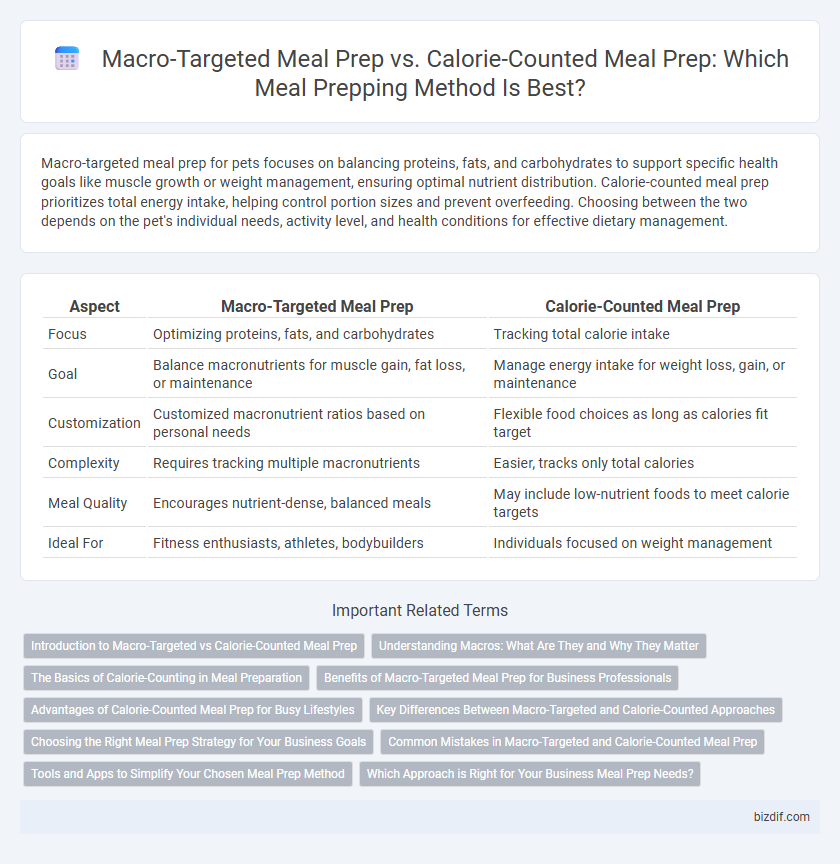Macro-targeted meal prep for pets focuses on balancing proteins, fats, and carbohydrates to support specific health goals like muscle growth or weight management, ensuring optimal nutrient distribution. Calorie-counted meal prep prioritizes total energy intake, helping control portion sizes and prevent overfeeding. Choosing between the two depends on the pet's individual needs, activity level, and health conditions for effective dietary management.
Table of Comparison
| Aspect | Macro-Targeted Meal Prep | Calorie-Counted Meal Prep |
|---|---|---|
| Focus | Optimizing proteins, fats, and carbohydrates | Tracking total calorie intake |
| Goal | Balance macronutrients for muscle gain, fat loss, or maintenance | Manage energy intake for weight loss, gain, or maintenance |
| Customization | Customized macronutrient ratios based on personal needs | Flexible food choices as long as calories fit target |
| Complexity | Requires tracking multiple macronutrients | Easier, tracks only total calories |
| Meal Quality | Encourages nutrient-dense, balanced meals | May include low-nutrient foods to meet calorie targets |
| Ideal For | Fitness enthusiasts, athletes, bodybuilders | Individuals focused on weight management |
Introduction to Macro-Targeted vs Calorie-Counted Meal Prep
Macro-targeted meal prep focuses on balancing proteins, fats, and carbohydrates to meet specific dietary goals, optimizing nutrient intake for muscle gain, fat loss, or maintenance. Calorie-counted meal prep prioritizes total energy intake, ensuring that meals align with a daily calorie target regardless of macronutrient distribution. Understanding these approaches helps tailor meal planning strategies to individual fitness objectives and metabolic needs.
Understanding Macros: What Are They and Why They Matter
Macros, short for macronutrients, consist primarily of proteins, carbohydrates, and fats, which are essential for fueling the body and supporting metabolic functions. Understanding macros in meal prepping enables precise control over nutrient intake, optimizing muscle growth, energy levels, and overall health beyond merely tracking calories. Macro-targeted meal prep focuses on balancing these nutrients according to individual goals, ensuring that each meal supports specific fitness or wellness objectives effectively.
The Basics of Calorie-Counting in Meal Preparation
Calorie-counted meal prep involves strictly tracking the energy content of each ingredient to ensure daily intake aligns with specific goals, often measured in kilocalories (kcal). This approach focuses on portion control and precision, facilitating weight loss, maintenance, or muscle gain by managing caloric surplus or deficit. Unlike macro-targeted prep, calorie-counting does not prioritize nutrient ratios but prioritizes total energy consumption from carbohydrates, proteins, and fats combined.
Benefits of Macro-Targeted Meal Prep for Business Professionals
Macro-targeted meal prep offers business professionals precise control over protein, carbohydrate, and fat intake, supporting sustained energy and enhanced cognitive function throughout demanding workdays. Tailoring meals based on macronutrient ratios promotes muscle maintenance and mental clarity, critical for high performance and productivity. This approach reduces meal decision fatigue, streamlining nutrition management for busy schedules while aligning with individual fitness and wellness goals.
Advantages of Calorie-Counted Meal Prep for Busy Lifestyles
Calorie-counted meal prep offers precise energy intake control, facilitating weight management and fostering consistent dietary habits essential for busy lifestyles. Tracking calories simplifies meal planning by focusing on total energy consumption, reducing decision fatigue and saving time during meal prep. This approach supports balanced nutrition by allowing adjustments based on daily activity levels and metabolic needs, optimizing performance and recovery for active individuals.
Key Differences Between Macro-Targeted and Calorie-Counted Approaches
Macro-targeted meal prepping emphasizes balancing specific nutrients--proteins, fats, and carbohydrates--to optimize body composition and performance goals, while calorie-counted meal prepping centers solely on total energy intake to control weight. Macro tracking requires detailed measurement of nutrient amounts to ensure precise nutritional ratios, whereas calorie counting focuses on maintaining a caloric deficit or surplus without specifying nutrient distribution. Individuals seeking muscle gain or fat loss often prefer macro-targeting for tailored results, while those aiming for general weight management may find calorie counting simpler and more practical.
Choosing the Right Meal Prep Strategy for Your Business Goals
Macro-targeted meal prep emphasizes balancing proteins, fats, and carbohydrates to optimize muscle growth, fat loss, or athletic performance, making it ideal for clients with specific body composition goals. Calorie-counted meal prep prioritizes total energy intake to support weight management or metabolic health, beneficial for general fat loss or maintenance plans. Selecting the right meal prep strategy depends on whether your business focuses on precision nutrition for fitness outcomes or broader calorie control for mass-market appeal.
Common Mistakes in Macro-Targeted and Calorie-Counted Meal Prep
Common mistakes in macro-targeted meal prep include neglecting micronutrient balance and overlooking food quality, which can lead to nutrient deficiencies despite hitting macro targets. In calorie-counted meal prep, frequent errors involve inaccurate portion measurements and excluding the thermic effect of food, resulting in unintended caloric surpluses or deficits. Both approaches often suffer from inconsistent tracking and lack of meal variety, which can impede long-term adherence and overall nutritional adequacy.
Tools and Apps to Simplify Your Chosen Meal Prep Method
Using tools like MyFitnessPal and Cronometer streamlines calorie-counted meal prep by precisely tracking daily calorie intake and nutrient breakdown. Macro-targeted meal prep benefits from apps such as MacroFactor and Carb Manager that tailor meal plans to specific macronutrient goals, adjusting protein, fat, and carb ratios efficiently. Integration with smart kitchen scales and meal planning software enhances accuracy, making adherence to either meal prep method simpler and more effective.
Which Approach is Right for Your Business Meal Prep Needs?
Macro-targeted meal prep emphasizes balanced portions of proteins, fats, and carbohydrates tailored to specific fitness goals, ideal for clients seeking precise nutritional tracking and muscle gain or fat loss. Calorie-counted meal prep focuses on total energy intake, suitable for businesses targeting weight management or general health improvement without the complexity of tracking individual macros. Choosing the right approach depends on your client demographic: fitness enthusiasts benefit from macro-targeted options, while general wellness programs may prefer calorie-counted meal plans for simplicity and broader appeal.
Macro-targeted meal prep vs calorie-counted meal prep Infographic

 bizdif.com
bizdif.com